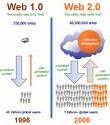
"Blogging and WEB 2.0
Why are we doing it?
I am part of a learning program called Learning 2.0. The aim of it is to let Library staff become familiar with Web 2.0 technologies which improves communication over the Web. Web 2.0 technologies are things such as webblogs (which you have accessed to be reading this), social bookmarking, wikis, podcasts, RSS feeds (and other forms of many to many publishing). Other Web 2.0 technologies include online web services such as eBay and Gmail. These are much better than read-only websites because people can upload as well as download. The phrase "Web 2.0" can also refer to the transition of websites from isolated information stand alone websites to an interlinked computing platform that acts like software to the user. Web 2.0 also includes a social element where users generate and distribute content, often with freedom to share and re-use.

A blog (a portmanteau of web log) is a website where entries are written in chronological order and commonly displayed in reverse chronological order. "Blog" can also be used as a verb, meaning to maintain or add content to a blog. Many blogs provide commentary or news on a particular subject such as food, politics, or local news; others function as more personal online diaries. A typical blog combines text, images, and links to other blogs, web pages, and other media related to its topic. The ability for readers to leave comments in an interactive format is an important part of many blogs. Most blogs are primarily textual, although some focus on art (artlog), photographs (photoblog), sketchblog, videos (vlog), music (MP3 blog), audio (podcasting) or sexual topics (Adult blog), and are part of a wider network of social media. Micro-blogging is another type of blogging which consists of blogs with very short posts.

Social bookmarking is a way for Internet users to store, organize, share and search bookmarks of web pages. In a social bookmarking system, users save links to web pages that they want to remember and/or share. These bookmarks are usually public, but depending on the service's features, may be saved privately, shared only with specific people or groups, shared only inside certain networks, or another combination of publicness and privateness. The allowed people can usually view these bookmarks chronologically, by category or tags, via a search engine, or even randomly. Most social bookmark services encourage users to organize their bookmarks with informal tags instead of the traditional browser-based system of folders, although some services feature categories/folders or a combination of folders and tags. They also enable viewing bookmarks associated with a chosen tag, and include information about the number of users who have bookmarked them. Some social bookmarking services also draw inferences from the relationship of tags to create clusters of tags or bookmarks. Many social bookmarking services provide web feeds for their lists of bookmarks, including lists organized by tags. This allows subscribers to become aware of new bookmarks as they are saved, shared, and tagged by other users. As these services have matured and grown more popular, they have added extra features such as ratings and comments on bookmarks, the ability to import and export bookmarks from browsers, emailing of bookmarks, web annotation, and groups or other social network features.
A wiki is a medium which can be edited by anyone with access to it, and provides an easy method for linking from one page to another. Wikis are typically collaborative websites, though there are now also single-user offline implementations. Ward Cunningham, developer of the first wiki, WikiWikiWeb, originally described it as "the simplest online database that could possibly work" One of the best-known wikis is Wikipedia.
A podcast is a digital media file, or a series of such files, that is distributed over the Internet using syndication feeds for playback on portable media players and personal computers. The term, like "radio", can refer either to the content itself or to the method by which it is syndicated; the latter is also termed podcasting. The host or author of a podcast is often called a podcaster. The term "podcast" is a portmanteau of the words "iPod" and "broadcast", the Apple iPod being the brand of portable media player for which the first podcasting scripts were developed (see history of podcasting). These scripts allow podcasts to be automatically transferred to a mobile device after they are downloaded. Though podcasters' web sites may also offer direct download or streaming of their content, a podcast is distinguished from other digital media formats by its ability to be syndicated, subscribed to, and downloaded automatically when new content is added, using an aggregator or feed reader capable of reading feed formats such as RSS or Atom.
RSS is a family of Web feed formats used to publish frequently updated content such as blog entries, news headlines or podcasts. An RSS document, which is called a "feed", "web feed", or "channel", contains either a summary of content from an associated web site or the full text. RSS makes it possible for people to keep up with their favorite web sites in an automated manner that's easier than checking them manually. RSS content can be read using software called a "feed reader" or an "aggregator." The user subscribes to a feed by entering the feed's link into the reader or by clicking an RSS icon in a browser that initiates the subscription process. The reader checks the user's subscribed feeds regularly for new content, downloading any updates that it finds. For a more detailed discussion of these early developments, see the history of web syndication technology














No comments:
Post a Comment